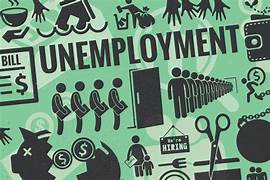Unemployment, types of unemployment, Unemployment Rate, causes

Understanding Unemployment: A Comprehensive Guide
Unemployment, a term synonymous with economic hardship and societal concerns, affects millions globally. Understanding its meaning, types, rates, and definition is crucial to addressing this complex issue.
Meaning of Unemployment:
Unemployment refers to the state of individuals who are actively seeking work but are unable to find it. They are willing and able to work but lack the opportunity to do so.
Types of Unemployment:
- Frictional Unemployment: This occurs during job transitions, as individuals leave one job and search for another. It is considered a natural part of a healthy economy.
- Structural Unemployment: This arises when a mismatch exists between the skills workers possess and the skills demanded by the job market. Technological advancements or changes in industry can contribute to this type of unemployment.
- Cyclical Unemployment: This is linked to economic downturns and recessions. When the economy weakens, businesses reduce production and may lay off workers.
- Seasonal Unemployment: Certain industries experience predictable fluctuations in demand throughout the year. This leads to periodic unemployment in sectors like tourism, construction, and agriculture.
- Disguised Unemployment: This refers to situations where underemployment exists, meaning individuals are employed in low-paying jobs with insufficient hours or wages.

Rate of Unemployment:
The unemployment rate is a crucial indicator of economic health. It is calculated by dividing the number of unemployed persons by the total labor force (employed and unemployed). A lower unemployment rate generally indicates a stronger economy.
Definition with Examples:
- An accountant who loses their job due to automation and struggles to find a position due to outdated skills is experiencing structural unemployment.
- A construction worker laid off during the winter months due to decreased construction activity is experiencing seasonal unemployment.
- A recent graduate actively searching for their first job is experiencing frictional unemployment.

Consequences of Unemployment:
Unemployment can have significant consequences for individuals and society as a whole. It can lead to financial hardship, reduced quality of life, and mental health issues. Increased crime rates and social unrest are also commonly associated with high unemployment.

Addressing Unemployment:
Combating unemployment requires a multi-pronged approach. This includes:
- Investing in education and training programs to equip individuals with the skills needed to compete in the modern economy.
- Promoting economic growth and creating new jobs through government policies and private sector initiatives.
- Providing unemployment benefits and support services to help individuals cope with job loss and
- transition to new employment.
Causes:
Several factors contribute to unemployment, including:
- Economic downturns: Recessions lead to decreased business activity and widespread layoffs.
- Technological advancements: Automation can replace certain jobs, leaving workers with outdated skills unemployed.
- Globalization: Businesses may move operations to countries with lower labor costs, leading to job losses in developed nations.
- Lack of education and training: Individuals without the necessary skills may struggle to find employment in a competitive job market.
- Discriminatory practices: Biases based on race, gender, age, or other factors can limit employment opportunities for certain groups.

Solutions of Unemployment
Combatting unemployment requires a multi-pronged approach, including:
- Investing in education and training: Equipping individuals with the skills needed for in-demand jobs is crucial.
- Promoting economic growth: Government policies and private sector initiatives can create new employment opportunities.
- Providing unemployment benefits and support services: This helps individuals cope with job loss and transition to new employment.
- Addressing discrimination: Implementing fair hiring practices and promoting diversity and inclusion in the workplace.
- Encouraging entrepreneurship: Fostering an environment that supports business creation can lead to increased job opportunities.

By understanding the complexities of unemployment and implementing effective solutions, we can work towards a world where everyone has the opportunity to contribute their talents and skills to a thriving economy.
The Looming Shadow: Understanding the Reality of Unemployment

Introduction of unemployment:
Unemployment, a constant specter haunting economies and individuals alike, remains a major concern worldwide. Its impact is far-reaching, affecting not only livelihoods but also social stability and mental wellbeing. In today’s interconnected world, understanding the complexities of unemployment is crucial for individuals and policymakers alike.
The Scope of the Problem:
Globally, the International Labour Organization (ILO) estimates that roughly 208 million people were unemployed in 2022. This translates to a global unemployment rate of 5.8%. However, the reality is more nuanced. Regional disparities are stark, with developing nations often bearing the brunt of unemployment. In India, for example, the unemployment rate is estimated to be around 7.5%.

Understanding the Causes:
The causes of unemployment are multifaceted and constantly evolving. Technological advancements, automation, and globalization have disrupted traditional industries, leading to job displacement. Additionally, economic downturns and recessions exacerbate the problem. Moreover, structural factors like inadequate education systems and skill mismatches further hinder employment prospects.
The Impact of Unemployment:
The consequences of unemployment are far-reaching. Individuals facing unemployment experience financial hardship, social exclusion, and a decline in mental health. Families are plunged into turmoil, and communities struggle to support their members. At a macro level, unemployment hinders economic growth and development.

A Multipronged Approach:
Addressing the complex issue of unemployment requires a multipronged approach. Governments need to invest in education and training programs to equip individuals with the skills needed for the changing job market. Additionally, fostering an environment of entrepreneurship and innovation can create new employment opportunities.
The Role of Technology:
While technology is often seen as a contributor to unemployment, it can also be harnessed as a tool to address the problem. Online platforms and digital skills training can connect job seekers with opportunities. Moreover, technology can facilitate flexible work arrangements and remote work, offering greater flexibility for individuals.
Individual Responsibility:
Individuals also have a role to play in navigating the changing landscape of employment. Continuous learning and adaptability are key to remaining competitive in the job market. Additionally, networking and building social capital can open doors to new opportunities.

Conclusion:
Unemployment remains a pressing global challenge. By understanding its causes and impacts, and through collective effort and individual responsibility, we can work towards a future where everyone has the opportunity to thrive.
Questions:
- What is the global unemployment rate?
- How does unemployment affect individuals and communities?
- What are the main causes of unemployment?
- How can technology be used to address unemployment?
- What can individuals do to stay competitive in the job market?
That’s all for Unemployment, types of unemployment, Unemployment Rate, causes of unemployment
Hoe did you find Unemployment, types of unemployment, Unemployment Rate, causes , if you like it please do like, share, and comment.
For more articles like this you can click this link https://stationvidya.com/casteism-meaning-definition-role-and-impact-of-casteism/
Or for more articles you want to check you can visit Stationvidya.com
Leave a Reply